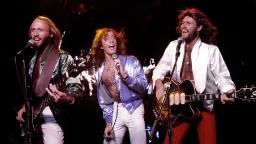[ad_1]

Director Frank Marshall kicks off with the brothers — Barry, Robin and Maurice — acting at a rapturous enviornment in 1979, two years after the “Saturday Night time Fever” soundtrack unleashed a flurry of hits, whereas sowing the seeds for what would grow to be a backlash in opposition to disco music. The movie then jumps 40 years forward, to an aged Barry, final surviving member, who ruefully cites his reminiscences and says, “Somebody will probably be left in the long run.”
What follows consists of a number of components, together with the brothers’ distinctive collaborative fashion — truly writing songs within the studio whereas recording — exploring the difficult dynamics of working professionally with household and charting the Gibbs’ rise, breakup, reunion, staggering success, the radioactive interval that got here after, and at last a measure of redemption.
Past Barry — three years older than his twin brothers, and a dozen older than Andy, who turned a teen heartthrob as a solo act — Marshall and author Mark Monroe speak to quite a few associates and shrewdly solicit third-party voices like Justin Timberlake Nick Jonas, who within the latter case can handle the issues related to having a musical enterprise with siblings.
Maybe what comes via the loudest is the thought of the Bee Gees as “chameleons of pop,” as one critic places it, repeatedly reinventing themselves within the course of.
That included principally stumbling into their falsetto singing fashion on the tune “Nights on Broadway,” then consciously pivoting to use it on “Saturday Night time Fever,” whose wild recognition — yielding 4 No. 1 hits — not solely powered the film however performed a direct position in producer Robert Stigwood securing the huge launch from Paramount that fueled its box-office bounty.
“How Can You Mend a Damaged Coronary heart” (a title derived from one other hit) is filled with such anecdotes. To quote a couple of, there’s father Hugh pushing them, stage-dad fashion, of their early years; “You Ought to Be Dancing” exploding in homosexual golf equipment that drove the disco craze earlier than it percolated into the mainstream; and different artists in search of them out to put in writing hit songs after the band’s shine pale. Pop staples like Barbra Streisand’s “Girl in Love” and the Dolly Parton-Kenny Rogers duet “Islands within the Stream” have been the end result.
Nonetheless, the ebullient, at-times joyous nature of the music is offset by the melancholy tone of the movie, which makes a fairly convincing case that the Bee Gees — for all their gaudy gold data and even gaudier gold chains — have been underappreciated and, in some quarters, disproportionately vilified.
“Once you grow to be well-known you suppose that everybody loves you, and so they’re gonna love you without end. And it is not true,” Barry says.
The Bee Gees have been adored, hated and as seen via Marshall’s lens, considerably forgotten. But after watching this documentary, even when you did not have an particularly deep love for the band of their heyday, you may end up buzzing these tunes yet again.
“The Bee Gees: How Can You Mend a Damaged Coronary heart” premieres Dec. 12 at 8 p.m. ET on HBO, which, like CNN, is a unit of WarnerMedia.
[ad_2]











